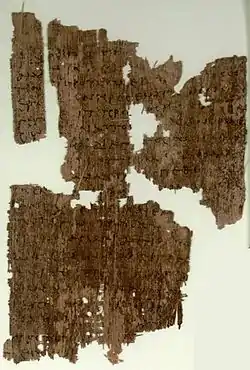| New Testament manuscript | |
 | |
| Name | P. Oxy. 4445 |
|---|---|
| Sign | 𝔓106 |
| Text | Gospel of John 1:29-35; 1:40-46 |
| Date | 3rd century |
| Script | Greek |
| Found | Oxyrhynchus, Egypt |
| Now at | Sackler Library |
| Cite | W. E. H. Cockle, OP LXIV (1997), pp. 11-14 |
| Size | 13 x 8.8 cm |
| Type | Alexandrian text-type |
| Category | I |
Papyrus 106, designated by 𝔓106 (in the Gregory-Aland numbering of New Testament manuscripts), is a fragmentary manuscript of the Gospel of John from the New Testament in Greek written on papyrus. It contains text from John 1:29-35 & 1:40-46. Using the study of comparative writing styles (palaeography), it has been assigned assigned to the early 3rd century.[1] The manuscript is currently housed at the Sackler Library (Papyrology Rooms, shelf number P. Oxy. 4445) at Oxford University in Oxford, England.[2]
Description
The manuscript is made of papyrus, and originally would have been around 12.5 cm x 23 cm, with about 35 lines per page.[3] Due to pagination being extant (gamma/Γ (=3) on the front and delta/Δ (=4) on the reverse of the leaf), this indicates that the manuscript was either a single codex of John, or had John at the beginning of a collection.[1]: 33
Textual Character
Despite its fragmentary nature, the text of the manuscript is considered a representative of the Alexandrian text-type (or rather proto-Alexandrian), bearing familiarity to 𝔓66, 𝔓75, Codex Sinaiticus (א), and Vaticanus (B).[1] The text-types are groups of different New Testament manuscripts which share specific or generally related readings, which then differ from each other group, and thus the conflicting readings can separate out the groups.[4]: 231–232 These are then used to determine the original text as published; there are three main groups with names: Alexandrian, Western, and Byzantine.[4]: 306–307
Some notable readings
Below are some readings of the manuscript and how they relate to other manuscripts of the New Testament.[5]
John 1:30:
- υπερ (on behalf of): 𝔓106 𝔓5 𝔓66 𝔓75 א* B C* Ws pc
- περι (concerning): א2 A C3 L Θ Ψ 0101 ƒ1 ƒ13 33 ; Epiph
- περη (misspelling for on behalf of): C2
John 1:32 (1)
John 1:32 (2)
- καταβαινον ως περιστεραν (descended as a dove): 𝔓106 𝔓55 𝔓75 A B C
- καταβαινον ωσει περιστερὰν (descended as if like a dove) : 𝔓66 K P Δ 0101 ƒ1 ƒ13 700 892 1241 1424 l 2211 pm
- ως περιστεραν καταβαινον (as a dove descended) : א
John 1:34
- εκλεκτος (chosen) : 𝔓106 𝔓5 א* b e ff2 Syriac Curetonian (syc s).[6]
- υς (υιος) (son) : 𝔓66 𝔓75 א2 A B C D W Θ Ψ 083
John 1:42
- ιωαννου (of John) : 𝔓106 𝔓66 𝔓75 א B* L Ws 33 pc it co
- ιωαννα (to John) : Θ 1241 pc vg
- ιωνα (Jonah) : A B2 Ψ ƒ1 ƒ13 c q vgcl sy boms; Epiph
John 1:45
John 1:46
See also
References
- 1 2 3 Comfort, Philip Wesley (2005). Encountering the Manuscripts: An Introduction to New Testament Paleography & Textual Criticism. Nashville, Tennessee: Broadman & Holman. p. 75.
- ↑ "Liste Handschriften". Münster: Institute for New Testament Textual Research. Retrieved 27 August 2011.
- ↑ Comfort, Philip Wesley; Barrett, David P. (2001). The Text of the Earliest New Testament Greek manuscripts (2 ed.). Wheaton, Illinois: Tyndale House. p. 645. ISBN 0-8423-5265-1.
- 1 2 Metzger, Bruce Manning; Ehrman, Bart D. (2005). The Text of the New Testament: Its Transmission, Corruption and Restoration (4th ed.). Oxford: Oxford University Press. ISBN 0-19-516667-1.
- ↑ Taken from NA27 Edition Apparatus, and http://ntvmr.uni-muenster.de/nt-transcripts Archived 2015-06-13 at the Wayback Machine
- ↑ Peter M. Head The Habits of New Testament Copyists Singular Readings in the Early Fragmentary Papyri of John Biblica 85 (2004) p. 403.
Further reading
- W. E. H. Cockle, The Oxyrhynchus Papyri LXV (London: 1998), pp. 11–14.
External links
Images
- P.Oxy.LXIV 4445 from Papyrology at Oxford's "POxy: Oxyrhynchus Online"
- 𝔓106 recto
- 𝔓106 verso
Official registration
- "Continuation of the Manuscript List" Institute for New Testament Textual Research, University of Münster. Retrieved April 9, 2008